The Boreal Owl (Aegolius funereus) emerges as a captivating and enigmatic inhabitant of the boreal and subarctic forests in the Northern Hemisphere.
With its distinctive appearance and nocturnal habits, this small owl species has carved out a niche in the dense coniferous landscapes from North America to Europe and Asia.
Recognized for its round facial disc, cryptic plumage, and haunting hoots, the Boreal Owl is a master of stealthy nocturnal hunting, preying predominantly on small mammals.
The species exhibits intriguing nesting behaviors, often utilizing tree cavities or repurposing abandoned nests.
The Boreal Owl’s adaptability is reflected in its global presence, marked by seven recognized subspecies across various geographic regions.
As a sentinel of these remote woodlands, the Boreal Owl invites exploration into the intricacies of its life history, revealing the profound connections it shares with its forested habitats. So, stay focused.
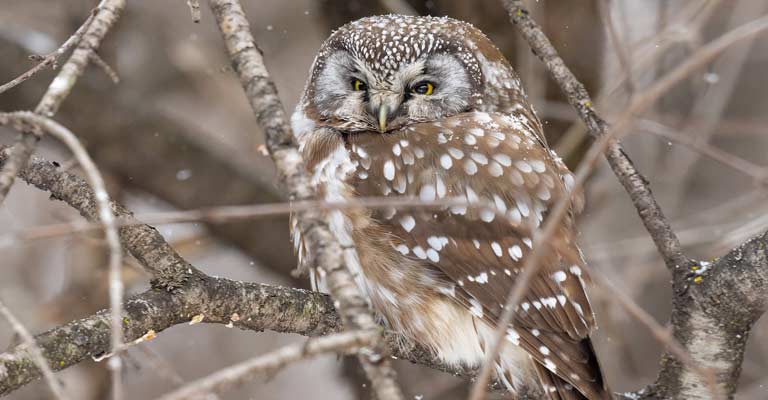
Taxonomy of Boreal Owl
Here is a convenient table summarizing the taxonomy details of the Boreal Owl:
| Taxonomic Rank | Classification |
| Domain | Eukaryota |
| Kingdom | Animalia |
| Phylum | Chordata |
| Class | Aves |
| Order | Strigiformes |
| Family | Strigidae |
| Genus | Aegolius |
| Species | A. funereus |
The Boreal Owl (Aegolius funereus) encompasses a diverse array of subspecies, each with its unique range and ecological adaptations.
These seven recognized subspecies contribute to the overall richness and adaptability of the species across varied landscapes:
- A.f. richardsoni (Bonaparte, 1838): Thriving in the Arctic expanses, A.f. richardsoni claims territory in Alaska, northern Canada, and the northern United States. This subspecies showcases the Boreal Owl’s ability to endure harsh conditions characteristic of high latitudes.
- A.f funereus (Linnaeus, 1758): As the nominate subspecies, A.f. funereus dominates European landscapes from Scandinavia to the Pyrenees and east to the Urals, highlighting the owl’s adaptability across temperate and diverse environments.
- A.f. magnus (Buturlin, 1907): In the remote reaches of northeast Siberia, A.f. magnus exemplifies the Boreal Owl’s capacity to navigate the vast, cold expanses of this Siberian wilderness.
- A.f. sibiricus (Buturlin, 1910): In southeast and south Siberia, A.f. sibiricus finds its home, showcasing the owl’s versatility in adapting to the diverse ecosystems spanning the Siberian landscape.
- A.f. pallens (Schalow, 1908): In the expansive west and central Siberian territories, A.f. pallens demonstrates the Boreal Owl’s resilience in the face of the challenges posed by the vast taiga and boreal forests.
- A.f. caucasicus (Buturlin, 1907): Among the peaks and valleys of the Caucasus Mountains, A.f. caucasicus reveals the owl’s ability to navigate the rugged terrain and elevations of this mountainous region.
- A.f. beickianus Stresemann, 1928: Extending its range from northwest India to southwest China, A.f. beickianus showcases the Boreal Owl’s adaptability to a diverse array of habitats, from the subtropical forests of India to the high-altitude landscapes of the Himalayas.
The collective existence of these subspecies underscores the Boreal Owl’s ability to thrive across a vast range of environments, reflecting the species’ remarkable adaptability and evolutionary diversity.
Each subspecies contributes to the intricate tapestry of the Boreal Owl’s presence in ecosystems across the Northern Hemisphere.
Identifying Characteristics of Boreal Owl
The Boreal Owl (Aegolius funereus) is a small but distinctive owl species found in boreal forests across the Northern Hemisphere.
Identifying this enigmatic bird involves paying attention to various physical and behavioral characteristics. Here are some key points to help you identify the Boreal Owl:
Size and Shape
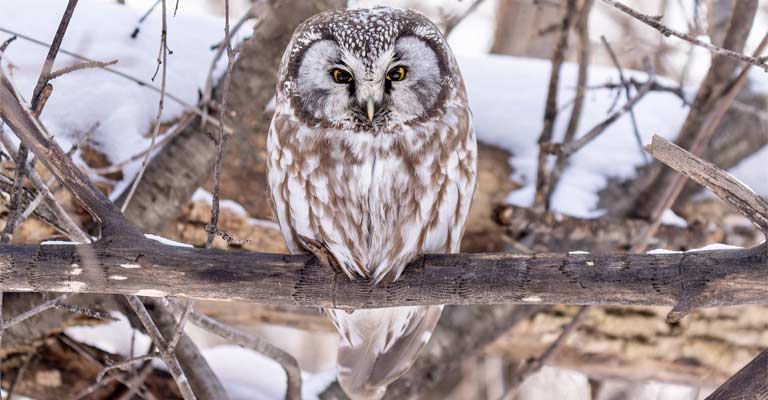
The Boreal Owl is relatively small, measuring about 9 to 11 inches in length. Its compact body and round head contribute to its distinctive appearance.
Despite its small size, it possesses a robust build with a wingspan of approximately 21 to 24 inches.
Coloration
The plumage of the Boreal Owl is characterized by a striking combination of brown and white.
The upper parts are dark brown, featuring a pattern of spots and streaks that help camouflage the bird amidst the tree bark. The underparts are pale with a scattering of fine brown streaks.
Facial Disc and Eyes
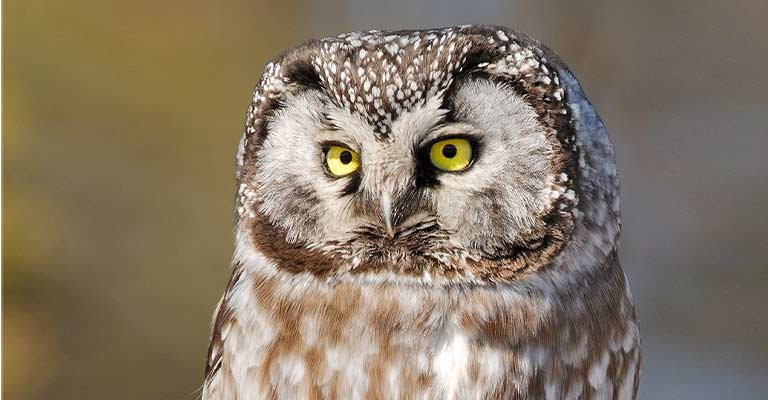
Like many owl species, the Boreal Owl has a facial disc, a circular arrangement of feathers around its face.
The facial disc is often grayish-brown with a prominent white “X” shape between the eyes. Its eyes are typically yellow or yellowish-brown, adding to its distinctive facial appearance.
Nocturnal Behavior
Boreal Owls are primarily nocturnal hunters, meaning they are most active during the night.
This behavior includes their characteristic hooting, a sound often described as a series of soft, mellow, and haunting calls. These vocalizations can help identify their presence in the forest.
Habitat Preferences
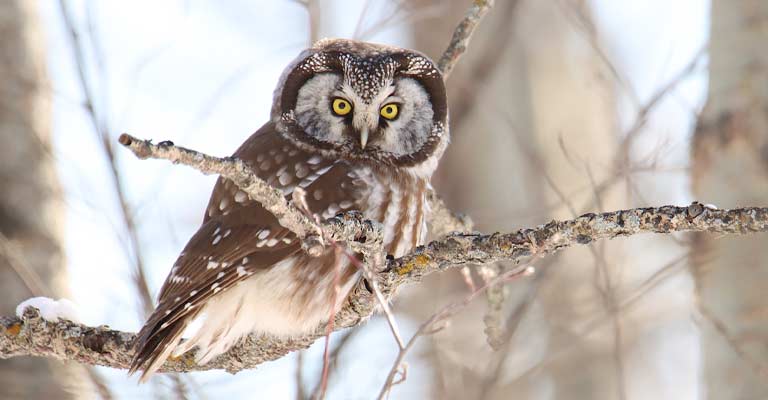
These owls inhabit coniferous and mixed forests, particularly those in the boreal and subarctic regions.
They prefer areas with dense tree cover, providing suitable roosting and nesting sites. Look for them in mature forests with a mix of spruce, fir, and pine trees.
Talon Structure
The Boreal Owl has powerful talons adapted for catching small mammals like voles and shrews.
Examining the talon structure can provide insights into its hunting habits. The presence of relatively long and strong talons indicates its specialization in capturing prey on the ground.
Flight Pattern
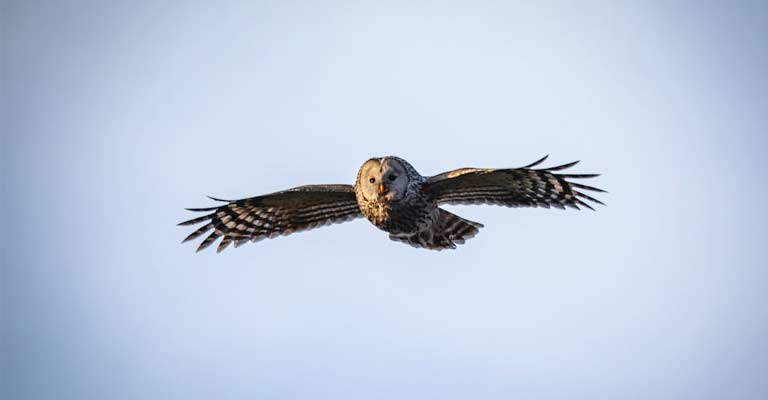
When in flight, the Boreal Owl exhibits a buoyant and direct style. Its wings are relatively short and rounded, allowing for agile maneuvers through densely wooded areas.
Pay attention to this distinctive flight pattern, especially during dusk or dawn when they are most active.
Geographical Distribution
Understanding the geographical distribution is crucial for accurate identification. Boreal Owls are found in North America, Europe, and Asia, with populations scattered across boreal and subarctic forests.
Knowing the specific range of this owl can help eliminate confusion with other owl species.
Identifying the Boreal Owl involves considering its size, coloration, facial features, behavior, habitat, talon structure, flight pattern, and geographical distribution.
Combining these characteristics will enhance your ability to recognize this captivating owl species in its natural environment.
Boreal Owl As a Hunter Bird
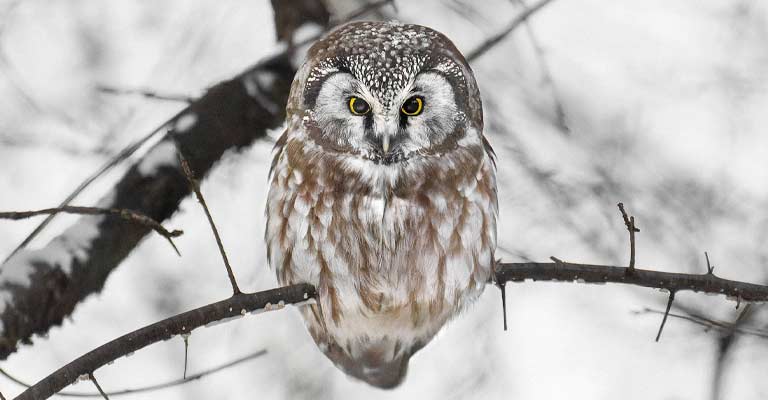
The Boreal Owl, renowned for its prowess as a hunter, has evolved specialized adaptations that make it a formidable predator in its boreal forest habitat.
Equipped with keen nocturnal vision and acute hearing, this owl is a skilled night hunter.
Its facial disc, a unique feature among owls, functions like a satellite dish, channeling sound to its ears and aiding in precise localization of prey.
Boreal Owls primarily feed on small mammals, such as voles and shrews, showcasing their versatility as skilled hunters on the forest floor.
Their powerful talons and sharp beak contribute to an effective hunting strategy, allowing them to capture and consume prey with remarkable precision.
Additionally, their cryptic plumage and stealthy flight enable them to navigate through dense vegetation without alerting potential prey.
As a hunter bird, the Boreal Owl exemplifies the intricacies of adaptation, combining sensory acuity with physical prowess to thrive in the challenging conditions of the boreal ecosystem.
Boreal Owl Life History
The Boreal Owl (Aegolius funereus), a captivating denizen of boreal forests, boasts a rich and intricate life history.
From its feeding habits to breeding behaviors, the Boreal Owl’s life is shaped by the unique challenges and opportunities of its habitat.
Food
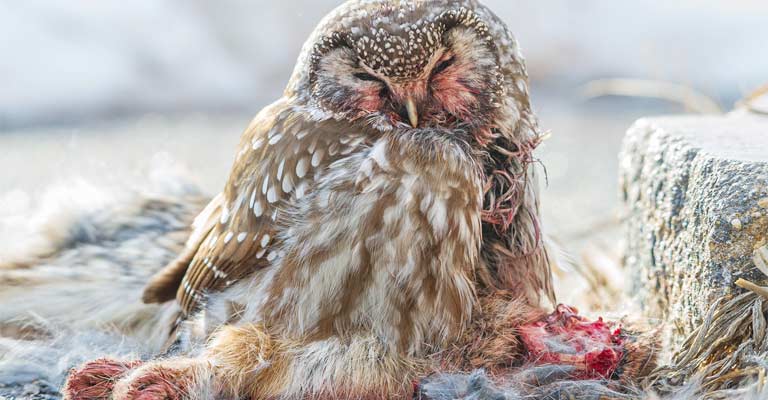
Boreal Owls are consummate hunters, specializing in small mammals like voles and shrews. Their nocturnal nature aids in stealthy hunting during the night, employing keen vision and exceptional hearing.
The owls’ powerful talons and sharp beaks facilitate capturing and consuming prey with precision, highlighting their adaptation to a carnivorous diet.
Habitat
Found in boreal and subarctic regions of North America, Europe, and Asia, Boreal Owls prefer mature coniferous and mixed forests.
These habitats offer ideal conditions for roosting, nesting, and hunting, with an abundance of trees providing both shelter and hunting grounds.
Range Map
The Boreal Owl’s range spans vast expanses of the Northern Hemisphere, as depicted in its distribution map.
Notable concentrations can be observed in the boreal forests of Canada, Scandinavia, Russia, and parts of Asia.
Understanding their geographical distribution is crucial for conservation efforts and habitat preservation.
Breeding
Breeding season for Boreal Owls typically occurs from February to June. Nesting in tree cavities or abandoned nests of other birds, these owls lay a clutch of 3 to 6 eggs.
The female incubates the eggs while the male provides food, showcasing a collaborative effort in raising the offspring.
Diseases
Boreal Owls, like many bird species, are susceptible to various diseases. Avian diseases, such as avian influenza and West Nile virus, can impact their populations.
Monitoring and understanding disease dynamics are crucial for effective conservation strategies.
Treatment
In the face of diseases, prompt veterinary intervention is essential.
Rehabilitation centers play a vital role in treating injured or sick Boreal Owls, providing medical care, and, when possible, reintroducing them to their natural habitat.
Addressing the root causes of diseases, such as habitat degradation, is also integral to long-term conservation.
Conservation
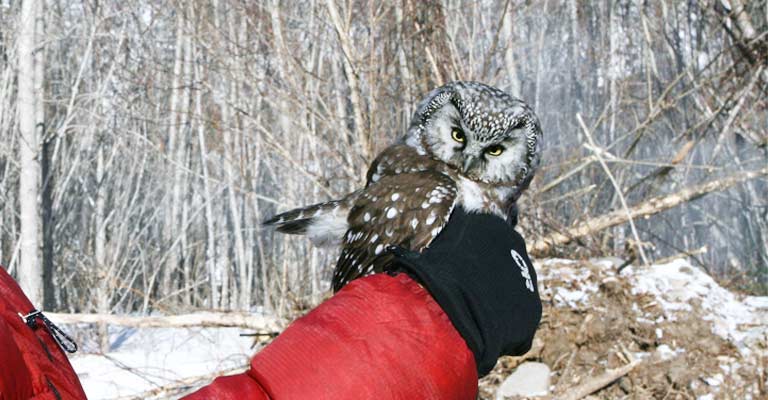
Boreal Owls face conservation challenges due to habitat loss, climate change, and human activities.
Conservation efforts focus on preserving their critical habitats, implementing sustainable forestry practices, and raising awareness about the importance of these owls in maintaining ecosystem balance.
International collaborations and research contribute to comprehensive conservation strategies aimed at ensuring the survival of this unique bird species.
The Boreal Owl’s life history is a testament to the delicate balance between adaptation, environmental challenges, and the human responsibility to conserve these remarkable creatures and the ecosystems they inhabit.
Nesting Habit of Boreal Owl
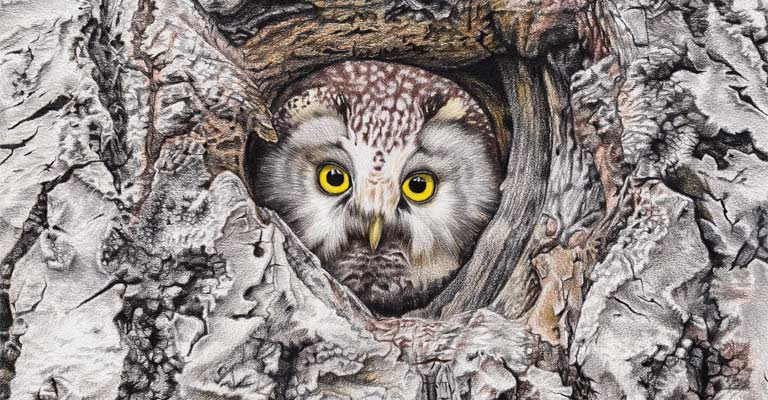
Nesting Details of Boreal Owl
| Nesting Characteristic | Details |
| Clutch Size | 3 to 6 eggs |
| Number of Broods | Usually one per breeding season |
| Egg Length | Approximately 1.2 inches (3 cm) |
| Egg Width | Approximately 1 inch (2.5 cm) |
| Incubation Period | Around 26 to 32 days |
| Nestling Period | 22 to 28 days |
| Egg Description | White and nearly spherical with a smooth texture |
The Boreal Owl’s nesting habits reflect its adaptability to the challenging boreal forest environment.
These owls typically lay a clutch of 3 to 6 eggs, with females incubating the eggs for about 26 to 32 days. Once hatched, the nestlings require another 22 to 28 days to fledge.
The choice of nesting sites involves utilizing tree cavities or abandoned nests, providing shelter and protection for the vulnerable young.
The eggs, approximately 1.2 inches in length and 1 inch in width are distinctive with their white color and nearly spherical shape.
Boreal Owls, exhibiting dedicated parenting, invest time and effort in raising their offspring, contributing to the intricate life history of this remarkable bird.
10 Surprising Facts About Boreal Owl
The Boreal Owl, with its elusive nature and captivating presence in boreal forests, harbors a trove of surprising facts that add to its mystique.
Here are 10 intriguing aspects of this remarkable owl that might just leave you in awe.
- Nocturnal Virtuoso: Boreal Owls are consummate night hunters, relying on their keen nocturnal vision and acute hearing to navigate and capture prey in the dark. Their haunting hoots resonate through the silent boreal forests, revealing their prowess as nocturnal virtuosos.
- Size Defying Talons: Despite their small size, Boreal Owls possess remarkably powerful talons. These talons are adapted for capturing small mammals with precision, showcasing the owl’s efficiency as a skilled predator.
- Unusual Nesting Sites: Boreal Owls exhibit a penchant for unique nesting sites. While they often use tree cavities, they’ve been known to repurpose abandoned nests of other birds, showcasing their adaptability and resourcefulness.
- Cryptic Plumage: The owl’s plumage, a mix of dark browns and whites, serves as excellent camouflage against the tree bark. This cryptic coloration aids in concealing the owl during daytime roosting, adding to its stealthy nature.
- Synchronized Hooting: During the breeding season, Boreal Owls engage in synchronized hooting with their mates. This vocal communication reinforces pair bonds and territorial boundaries, creating a harmonious symphony in the otherwise quiet forests.
- Global Distribution: Boreal Owls have a vast geographical range, spanning the boreal and subarctic regions of North America, Europe, and Asia. Their adaptability to diverse environments contributes to their widespread presence.
- Minimal Winter Movement: Unlike some migratory birds, Boreal Owls display minimal winter movements. Instead, they endure the harsh winter conditions, showcasing their resilience in the face of challenging climates.
- Longevity in Captivity: In captivity, Boreal Owls have been known to live longer than their wild counterparts, with some individuals reaching up to 18 years. This longevity provides valuable insights into their behavior and biology.
- Displacement Tolerance: Boreal Owls exhibit a remarkable tolerance for habitat displacement. They can adapt to altered landscapes and may utilize human-made structures, showcasing a level of adaptability in the face of changing environments.
- Conservation Challenges: Despite their adaptability, Boreal Owls face conservation challenges due to habitat loss and climate change. Their dependence on specific habitats makes them vulnerable, emphasizing the need for sustained conservation efforts to ensure their continued existence.
In the realm of avian wonders, the Boreal Owl stands out with its surprising traits, offering a glimpse into the intricacies of its life in the secretive boreal forests.
Wrapping Up
The Boreal Owl, a mystical inhabitant of boreal forests, captivates with its nocturnal prowess, unique nesting habits, and surprising adaptations.
From synchronized hooting to resilient longevity, these owls embody the enchanting secrets concealed within the vast northern woodlands.
As we delve into their nocturnal world, the intricacies of their life history and the challenges they face underscore the importance of conservation.
It is a call to action, urging us to preserve the delicate balance of their habitats and ensure the continued existence of this extraordinary bird species. Thank you so much.